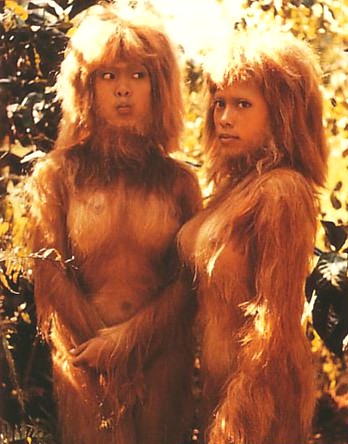
August 12, 2007

What are the lesser-known cryptids that you know about, that you are pursuing, and/or that you feel should get more attention?
Nowadays, it is easy to come up with a list of popular well-known cryptids. Click on this one of the top 50 here, to see what I mean.
But we all know there are vast numbers of cryptids out there that remain hidden, and even hidden from media attention.
One task I tackled as the 1990s ended was to bring cryptozoology to a broader audience, introduce the diversity of the searchers, and highlight more than the big three cryptids – Bigfoot, Nessie, and Yeti. One of the reasons Cryptozoology A to Z: The Encyclopedia of Loch Monsters, Sasquatch, Chupacabras, and Other Authentic Mysteries of Nature (NY: Simon and Schuster, 1999) is still in print probably is because its 200 entries talk about a lot of often overlooked cryptids that people forget are out there.
Likewise, Chad Arment’s Cryptozoology and the Investigation of Lesser-Known Mystery Animals (Coachwhip Publications, 2006) extends the information on the non-stars of cryptozoology. Arment collected stories that included ones about unknown coelacanths, mystery pigs, luminous spiders, flying snakes, and the mystery bird Paul Gauguin painted.
But what if we search even deeper for more lesser-knowns today? Let me challenge you.
Tony Lucas, New Zealand cryptozoologist, has sent in his personal list of relatively unknown cryptids – let’s say the unknown unknowns in Oz – to kick off this exercise. The South Island Puma, New Zealand Sea Monster, and Waitoreke are cryptids that people have perhaps heard about before. But Lucas’ list below concentrates on the lesser-known cryptids of New Zealand.
After you read the Oz roundup, go ahead and share your list of those cryptids you feel are ignored, overlooked, and neglected by the mainstream media and by most cryptozoological sites.
They won’t be ignored for long if any of us here have anything to say about it, but, of course, the first step is to become aware of them.
^^^^^^^^^^^^^^^^^^
Lesser Known Cryptids of New Zealand by Tony Lucas
Pouakai

The Maori (or Ma¯ori) folklore tells of the Pouakai, a large bird that often attacked warriors and was quite capable of carrying off children. Could this have been the now extinct Haasts eagle, Harpagornis moorei (shown above), said to be one of the world’s largest living eagle? Female Haast’s eagles weighed 10 to 15 kg (22 to 33 lb), and males weighed 9 to 10 kg (20 to 22 lb). They had a wingspan of roughly 2.6 to 3 m (8 to 10 ft) at most, which was short for a bird of the eagle’s weight (the largest Golden Eagles and Steller’s Sea Eagles may have wings of almost the same width), but aided them when hunting in the dense forests of New Zealand.
[Note: Harpagornis was recently shown to be synonymous with Hieraaetus, according to Darren Naish.]
Toanginas.
These creatures were eight to ten feet tall and hairy. They were feared by the people of the lower Wanganui River as they often viciously attacked fishermen in the area.
Rapuwai.

The above Taongoa-Tumuki mask represents the direct descendants of Rapuwai.
The Rapuwai were gigantic, slow, clumsy, hairy man like beasts. Strong and muscular they were however, very shy and retiring.
KaweKawau
Hopolodactylus delcourti is a two-foot long gecko known only from a single type specimen discovered in the basement of the Marseille Museum of Natural History in 1986. The lizard fits the Maori folklore description of a creature called the KaweKaweau.
Kumi Lizard – Ngarara.
The Maori spoke of the existence of a monitor-like lizard reaching a length of around five to six feet. The Kumi Lizard was supposed to inhabit streams, and was proficient at burrowing. It had a serrated dorsal crest and large teeth, which caused the upper lip to protrude.
Moehau – Maero.
This creature, which is slowly gaining “well-known status” outside New Zealand, is said to be of human stature with long hair, long arms that come down below the knee, and hands/feet tipped with sharp talons. The Moehau are reported to inhabit the Coromandel region of the North Island. Moehau are considered extremely dangerous to humans.
^^^^^^^^^^^^^^^^^^
What’s on your list of lesser-known cryptids?

About Loren Coleman
Loren Coleman is one of the world’s leading cryptozoologists, some say “the” leading living cryptozoologist. Certainly, he is acknowledged as the current living American researcher and writer who has most popularized cryptozoology in the late 20th and early 21st centuries.
Starting his fieldwork and investigations in 1960, after traveling and trekking extensively in pursuit of cryptozoological mysteries, Coleman began writing to share his experiences in 1969. An honorary member of Ivan T. Sanderson’s Society for the Investigation of the Unexplained in the 1970s, Coleman has been bestowed with similar honorary memberships of the North Idaho College Cryptozoology Club in 1983, and in subsequent years, that of the British Columbia Scientific Cryptozoology Club, CryptoSafari International, and other international organizations. He was also a Life Member and Benefactor of the International Society of Cryptozoology (now-defunct).
Loren Coleman’s daily blog, as a member of the Cryptomundo Team, served as an ongoing avenue of communication for the ever-growing body of cryptozoo news from 2005 through 2013. He returned as an infrequent contributor beginning Halloween week of 2015.
Coleman is the founder in 2003, and current director of the International Cryptozoology Museum in Portland, Maine.
Filed under Abominable Snowman, Almas, Bigfoot, Books, Cryptid Canids, Cryptomundo Exclusive, Cryptotourism, CryptoZoo News, Cryptozoologists, Cryptozoology, Dover Demon, Evidence, Expedition Reports, Eyewitness Accounts, Forensic Science, Homo floresiensis, Ivory-Billed Woodpecker, Lake Monsters, Living Dinosaurs, Lizard People, Loch Ness Monster, Malaysian Bigfoot, Media Appearances, Mothman, Mystery Cats, New Species, Ogopogo, Sasquatch, Sea Serpents, Skunk Apes, Swamp Monsters, Thunderbirds, Thylacine, Windigo, Yeti, Yowie